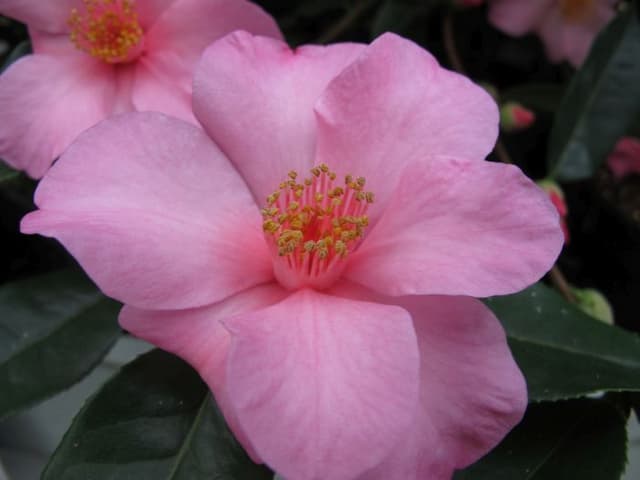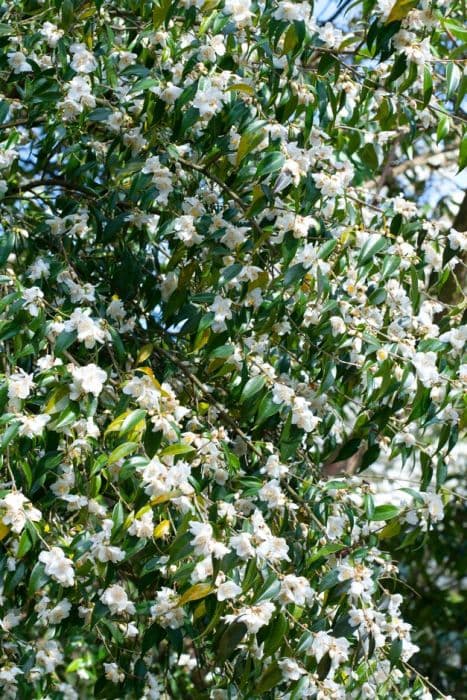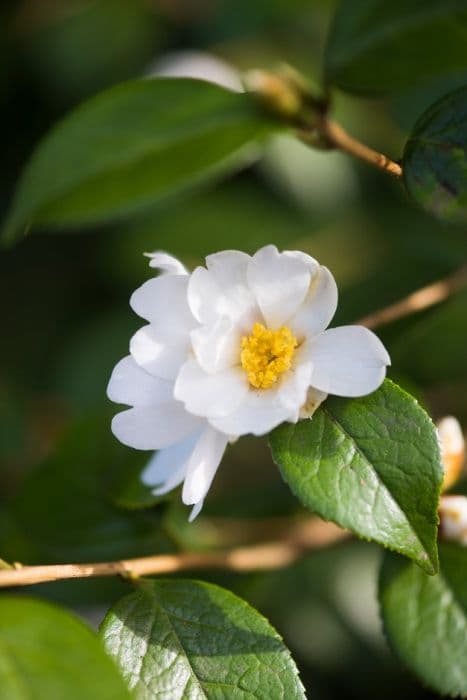Japanese camellia Camellia japonica 'Nuccio's Jewel'

ABOUT
Camellia japonica 'Nuccio's Jewel' is a flowering plant cherished for its striking ornamental features. The plant typically displays a lush, glossy green foliage that provides a rich backdrop to its standout blooms. The leaves are leathery and oval-shaped with finely serrated edges, emerging as a subtle element of the plant’s elegance. What captures the most attention are the flowers of 'Nuccio's Jewel', which are known for their mesmerizing appearance. The blooms exhibit a peony-like form, characterized by layers of ruffled petals that create a dense, full-bodied look. The flowers possess a luxurious blend of pink and white hues, presenting a multicolored effect that often transitions from a deep pink at the edges to a softer pink or almost white towards the center. This gradient of pink gives each bloom a unique and exquisite appearance. The buds of Camellia japonica 'Nuccio's Jewel' are equally as ornate, starting as perfectly formed tight spheres that hint at the beauty concealed within. As the petals unfurl, they reveal a textural tapestry of delicate yet robust petals, contributing further to the plant's visual appeal. Overall, 'Nuccio's Jewel' is a sumptuous display of color and form that is frequently used as an eye-catching specimen in ornamental gardens. Its beautiful blooms are significant among camellias, making this variety a favored choice for those looking to add a touch of refined beauty to their garden palette.
About this plant
 Names
NamesFamily
Theaceae.
Synonyms
Japanese Camellia, Rose of Winter.
Common names
Camellia japonica 'Nuccio's Jewel'.
 Toxicity
ToxicityTo humans
Camellias, in general, are not considered toxic to humans. If Camellia japonica 'Nuccio's Jewel', commonly known as camellia, is ingested, it is unlikely to cause any harmful effects or symptoms of poisoning. These plants are commonly grown for ornamental purposes and do not have a significant history of causing toxicity when parts of the plant are accidentally consumed by humans.
To pets
Camellias are also typically non-toxic to pets. If a pet, such as a dog or cat, ingests parts of Camellia japonica 'Nuccio's Jewel', which is simply known as camellia, they are not expected to experience symptoms of poisoning. However, it's always wise to prevent pets from eating plants, as ingestion can sometimes cause mild gastrointestinal upset due to the ingestion of non-food items, rather than toxicity from the plant itself.
 Characteristics
CharacteristicsLife cycle
Perennials
Foliage type
Evergreen
Color of leaves
Dark green
Flower color
Pink
Height
6-10 feet (1.8-3 meters)
Spread
6-10 feet (1.8-3 meters)
Plant type
Shrub
Hardiness zones
7
Native area
Japan
Benefits
 General Benefits
General Benefits- Ornamental Value: Showcases large, formal double flowers that provide a spectacular display in the garden.
- Variety of Colors: Comes in shades of pink and white with occasional stripes, adding to the visual appeal in a landscape setting.
- Evergreen Foliage: Retains green leaves year-round, ensuring continuous color even when not in bloom.
- Shade Tolerance: Thrives well in partial shade, making it versatile for different garden locations.
- Long Blooming Period: Offers a long flowering season from late winter through early spring.
- Low Maintenance: Requires minimal pruning and care once established, suitable for gardeners of all skill levels.
- Drought Tolerance: Once established, it has a good level of drought resistance, reducing the need for frequent watering.
- Pest Resistance: Displays a natural resistance to many pests, decreasing the need for chemical treatments.
- Winter Interest: Provides color and form in the garden during the dull winter months when few other plants are in bloom.
- Landscape Versatility: Can be used in a variety of landscaping designs, including borders, specimen planting, or as a hedge.
 Medical Properties
Medical PropertiesThis plant is not used for medical purposes.
 Air-purifying Qualities
Air-purifying QualitiesThis plant is not specifically known for air purifying qualities.
 Other Uses
Other Uses- Art Inspiration: The vivid blooms of Camellia can inspire artists and can be used as a subject for paintings, drawings, and other forms of visual art.
- Handcrafted Soaps: The petals of Camellia flowers can be incorporated into handcrafted soaps for their aesthetic appeal, without any claims to their medicinal properties.
- Fabric Dye: The petals may be used to create a natural dye for fabrics, offering a range of pink hues to textile artists and DIY enthusiasts.
- Floral Arrangements: Camellias are often used in floral arrangements and bridal bouquets because of their full, vibrant blooms and rich colors.
- Culinary Decoration: Edible varieties of Camellia flowers can be used to decorate cakes and pastries for an elegant touch.
- Photography: The striking appearance of Camellia can be a captivating subject for professional and amateur photographers alike.
- Plant-Based Crafts: The leaves and blooms can be used in plant-based crafts, such as making wreaths or pressed flower arrangements.
- Festive Decor: Camellia flowers and leaves can be used to create natural festive decorations during holidays, such as Christmas garlands or table centerpieces.
- Gardening Education: Camellias can be used in educational settings to teach horticulture and the process of growing and caring for flowering plants.
- Botanical Illustration: Camellia plants can be used as specimens for detailed botanical illustrations, which are valuable for educational purposes and artistic endeavors.
Interesting Facts
 Feng Shui
Feng ShuiThe Camellia is not used in Feng Shui practice.
 Zodiac Sign Compitability
Zodiac Sign CompitabilityThe Camellia is not used in astrology practice.
 Plant Symbolism
Plant Symbolism- Admiration: Camellia japonica, commonly known as the Japanese camellia, symbolizes deep admiration for someone's achievements or qualities.
- Perfection: The Japanese camellia represents the idea of perfection, due to its perfectly formed petals and elegant appearance.
- Long-lasting love: The endurance of the camellia flowers through different seasons is often associated with the enduring nature of love.
- Affection: Gifting camellias is a way to show affection or longing for someone, indicating a desire to be with the person you care about.
- Refinement: The lush and polished look of the camellia blossom suggests a sense of refinement and sophistication.
 Water
WaterCamellias, including 'Nuccio's Jewel,' prefer consistent moisture and should be watered deeply and thoroughly when the top inch of soil feels dry to the touch. In the absence of rainfall, water the plant with about 1 gallon of water per week to ensure the root zone is adequately moistened. During hot, dry periods, water needs may increase to twice per week. It’s essential to avoid over-watering, as camellias do not tolerate waterlogged soils, which can lead to root rot.
 Light
Light'Nuccio's Jewel' camellia thrives in partial shade with protection from the hot afternoon sun. The ideal spot would provide bright, indirect light in the morning with dappled or filtered shade during the afternoon. Direct sunlight, especially in the warmer months, can cause leaf scorch, so ensure the plant is positioned to avoid intense midday rays.
 Temperature
Temperature'Nuccio's Jewel' camellia is hardy and can survive in temperatures as low as 20 degrees Fahrenheit (-6 degrees Celsius) and as high as 85 degrees Fahrenheit (29 degrees Celsius). The ideal temperature range for growing this camellia is between 60 and 70 degrees Fahrenheit. These plants prefer a cooler climate and may struggle if exposed to extended periods of high heat above the maximum tolerance.
 Pruning
PruningPrune 'Nuccio's Jewel' camellia to maintain its shape, remove any dead or weak branches, and encourage new growth and flowering. The best time to prune is right after blooming ends, which typically is in the spring. It is not necessary to prune every year; however, if shaping or size reduction is required, do so sparingly to not remove next year's flower buds.
 Cleaning
CleaningAs needed
 Soil
SoilThe best soil mix for Camellia is well-aerated, rich in organic matter and acidic with a pH ranging from 5.5 to 6.5. A mix of 1/3 pine bark, 1/3 sphagnum peat moss, and 1/3 perlite or sand facilitates good drainage and aeration. Mulching with pine needles or bark helps maintain the desired acidity.
 Repotting
RepottingCamellias, including 'Nuccio's Jewel', generally need to be repotted every 2-3 years. Repotting is best done in late winter or early spring before the onset of new growth, ensuring minimal stress to the plant.
 Humidity & Misting
Humidity & MistingCamellia prefers a humid environment; the best humidity level ranges from 40% to 60%. High humidity is particularly important during the dry winter months if grown indoors.
 Suitable locations
Suitable locationsIndoor
Keep Camellia in bright, indirect light and maintain high humidity.
Outdoor
Plant in partial shade with shelter from strong winds and midday sun.
Hardiness zone
7-9 USDA
 Life cycle
Life cycleThe life cycle of Camellia japonica 'Nuccio's Jewel', commonly known as the Japanese camellia, begins with seed germination, which occurs when the environmental conditions are warm and moist, prompting the seed to sprout and develop a root system. From the seedling stage, it grows into a young plant with a few leaves, gradually maturing to a woody shrub with abundant, glossy green foliage. Throughout the spring, ‘Nuccio’s Jewel’, known for its ornate flowers, enters its flowering stage where buds form and blossom into large, peony-like blooms, typically pink with varying shades. These flowers are later pollinated by insects, leading to the formation of seed pods. After the flowering season, the plant enters a period of growth where it focuses energy on expanding its root and shoot systems. In its mature stage, the plant maintains a cycle of growth, flowering, and seed production annually, with proper care allowing it to live for several decades.
 Propogation
PropogationPropogation time
Spring-Early Summer
The Camellia japonica 'Nuccio's Jewel', commonly known as the Japanese camellia, is predominantly propagated through semi-hardwood cuttings. This method typically takes place during the late summer, once the current year's growth has begun to mature. To propagate using semi-hardwood cuttings, cuttings of about 4 to 6 inches (10 to 15 cm) length, with several leaves attached, are taken from the plant. The bottom 1 to 2 inches (2.5 to 5 cm) of the cutting should be stripped of leaves and dipped into a rooting hormone to encourage root development. After treating with hormone, the cutting is inserted into a potting medium that is kept moist but not wet, providing a balance of aeration and humidity. Cuttings are usually placed under a form of mist system or in a greenhouse with high humidity to ensure a conducive environment for rooting. It can take several months for the cutting to develop a sufficient root system and be ready for transplanting.









